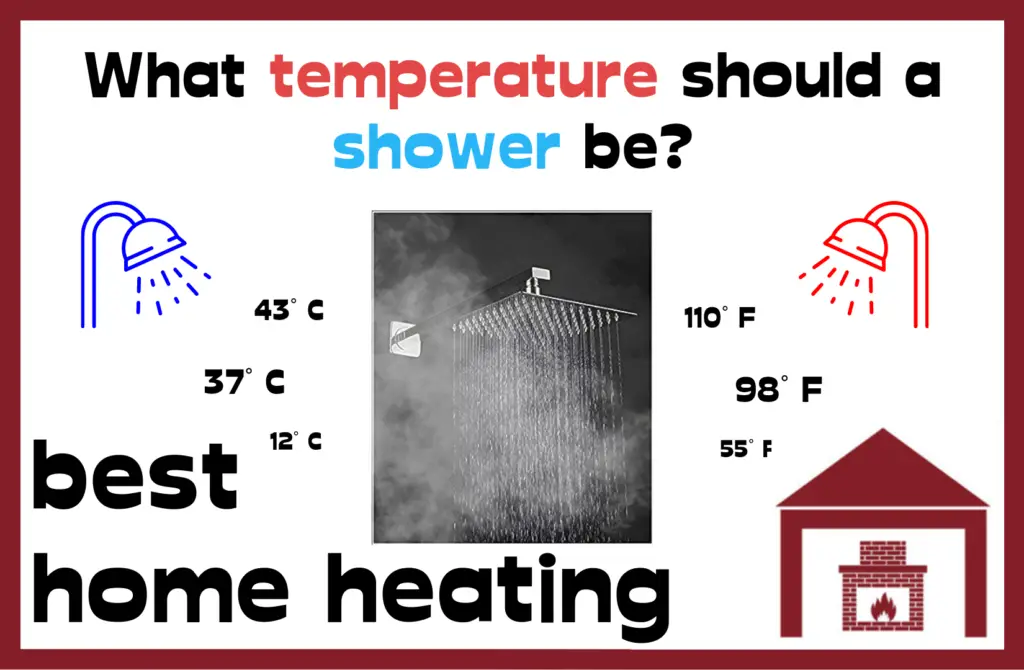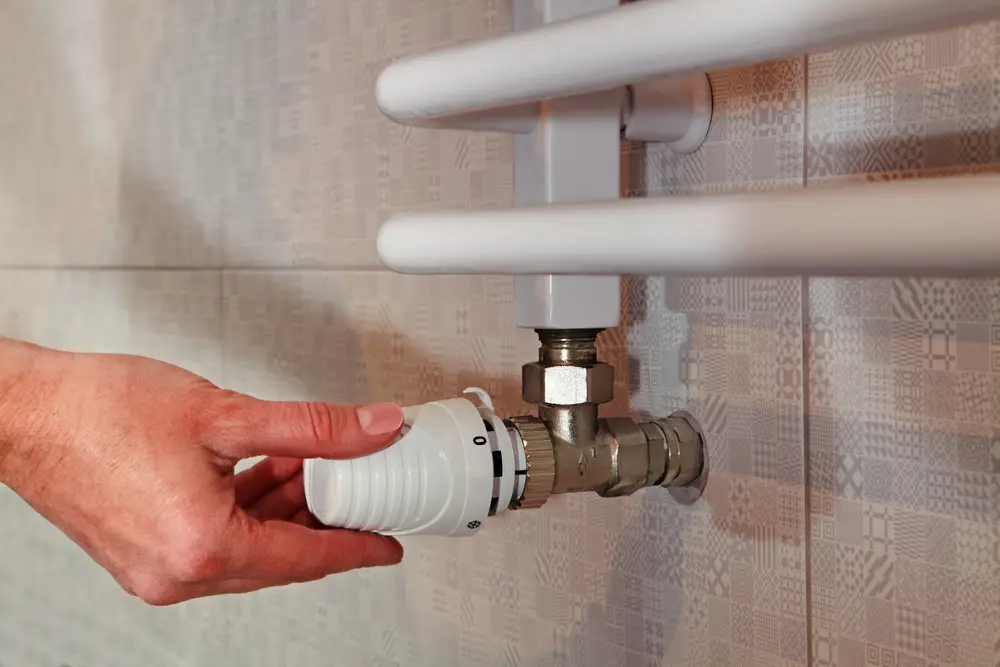The ideal shower temperature, balancing comfort and practicality, is a topic that often sparks debate among many individuals seeking the perfect balance between hot and cold water.
When it comes to shower temperature, no strict rules exist. Aim for 37-38.3°C on average, not exceeding 41°C per Chartered Institute of Plumbing and Heating Engineering. Newborns maximum at 37°C. Hotter temps lead to dry, irritated skin and lower blood pressure, causing lightheadedness.
Curious to know more about the ideal shower temperature? Read on to find out!

Shower water temperature vs bathing water temperature
Shower water temperature are the temperatures at which hot water should be delivered to your hot water tap outlet; they are not the temperatures at which you should bathe; for baths and showers, you will need to mix cold water with hot water.
What are the safe upper limits for shower temperatures?
Hot water is often held at approximately 60°C in the home, with the temperature at the tap typically hovering around 55°C. It would just take seconds to produce a significant deep tissue burn if you ran a bath at that temperature without adding any cool water. The Department of Health UK (NHS) advises that showering temperatures not exceed 41°C.
Safe upper limits for shower temperatures for babies
Young children have extremely sensitive skin, making them easily scalded by hot water. The best shower temperature for toddlers and small children is between 37°C and 38°C, whereas the ideal water temperature for newborns is 36°C. Check the water temperature before allowing your child to shower to ensure it is appropriate for them.
Safe upper limits for shower temperatures for elderly
As we age, we should gradually reduce our average shower temperature since our skin and hearts become less tolerant of hot water. Hot water can cause skin to dry out and become itchy, while increased blood flow to the skin might strain our cardiovascular system. As a result, the recommended shower temperature for the elderly is between 36°C and 38°C.
Safe upper limits for shower temperatures for Pregnant women
According to the NHS, a considerable increase in your core body temperature during pregnancy might be dangerous. As a result, it is advisable to set your shower temperature to the same as your body temperature: approximately 37°C.
Shower temperature that is best for your skin
Showering at lukewarm or colder temperatures is best for your skin. Hot water drains your skin of natural oils, which can cause dry and itchy skin, so keep your shower temperature between 37°C and 38°C.
If you have sensitive skin, your shower’s spray settings and temperature might both effect your bathing experience.
Shower temperature that is best for your hair
Similar to how hot water may dry out your skin, hot water can also remove natural oils from your hair. When washing colored hair in hot water, the color may fade more quickly than it would in water that is warmer. Aim for a range between 37°C and 38.3°C for the temperature.
What temperature is a cold shower?
Like most people, you might prefer warm showers to cold ones, but if that is the case, you might be losing out on some huge advantages. A cold shower is one when the water is below 21 degrees Celsius.
Our pores expand when we take a hot shower, but taking a cold shower will temporarily constrict them, allowing you to keep more of the healthy oils in your skin and hair. Consider sometimes washing off with cold water if you have dry skin or worry about brittle, dry hair.
Noradrenaline and beta-endorphin production are also stimulated by cold water. When we take a cold shower, electrical impulses are delivered from our nerve endings to our brain, and this chemical response may have an antidepressant impact on certain people. By boosting your immune system and making you more resilient to disease, taking a cold shower may prevent you from developing a cold.
Our bodies also automatically go into survival mode when we come in contact with cold water, which causes an increase in heart rate. Your circulatory system works overtime because of the cold water, which improves circulation throughout your body and causes your heart to pump more effectively.
How does a shower mechanism normally mix the water?
Effectively, mixer showers are used in all showers. A shower mixer valve very simply mixes water from your hot water source and your cold water supply to evenly balance the water temperature, much to how you have a basin mixer tap. Depending on your system, this enables water to mix, flow via a single outlet (a showerhead), and then be directed to several additional secondary channels (a bath filler, a shower wand).
There are different types of shower mixer valves.
Concealed shower valves
A concealed valve, often referred to as a sunken shower valve, is one that is camouflaged inside the shower wall, floor, or ceiling such that the only thing that is apparent to the eye is a sleek valve plate with covert controls or shower handles. To give your shower enclosure a neat and uncluttered finish, concealed thermostatic shower valves conceal pipes.
Exposed shower valves
An exposed valve is one that is placed outside of the shower wall, fixed to the bathroom floor or tiles, and has the shower pipes visible. It typically resembles a short, broad cylinder with cold and hot pipes on either side that is joined to the showerhead and other water outputs via an outside pipe.
Shower thermostatic valves
A thermostatic shower valve, as its name indicates, is a shower mixer that enables you to set a maximum water temperature to prevent scalding. A thermostatic mixer shower controls the water temperature extremely easily by restricting your ability to turn the valve from chilly to hot. This creates a physical barrier separating the temperatures of your water boiler and shower.
Are shower temperature thermostats normally accurate?
The main benefit of having a thermostatic valve is having complete control over the temperature of your shower. While your water heater can be set to 140° F to prevent bacterial contamination, the water that emerges from your shower head can always be 100° F. (set your maximum output temperature on the valve). The temperature of the water in your shower stays consistent thanks to thermostat valves.
The thermostatic shower tap is a mixer that enables the user to choose the desired temperature, which stays constant even when other taps in the same home are opened. Its operation is straightforward since all that is required is to choose the desired temperature with the handle, and in a flash, the thermostatic cold and hot water cartridge will automatically mix to swiftly reach the desired temperature.
The safe stop mechanism, which shuts water at 38 degrees Celsius to ensure safety, is typically included in thermostatic showers. If the supply of cold water is interrupted, this technology also turns off the hot water supply, reducing the danger of burns.
The temperature delivered to your body is usually accurate as these thermostats have very accurate measuring devices. Usually, digital thermostats are the most accurate in water temperature measurements. A thermostatic mixing valve may detect temperature in a variety of ways. Some contain a wax inlay that contracts and expands in reaction to the temperature of the water.

Conclusions
- The temperatures at which hot water should be delivered to your hot water tap outlet are referred to as shower water temperatures.
- Although there is no hard and fast rule about how hot or cold your shower water should be, the average shower temperature should be between 37°C and 38.3°C.
- It is better for your skin to shower at lukewarm or lower temps. Hot water depletes your skin’s natural oils, resulting in dry, irritated skin.
- Mixer showers are effectively employed in all showers. A shower mixer valve, similar to a basin mixer tap, simply combines water from your hot water source and your cold water supply to evenly balance the water temperature.
